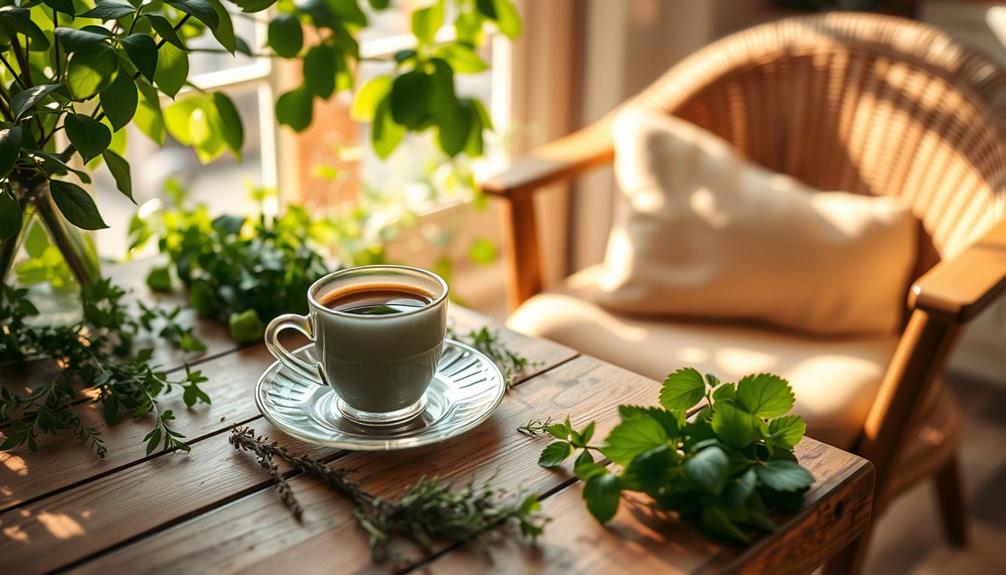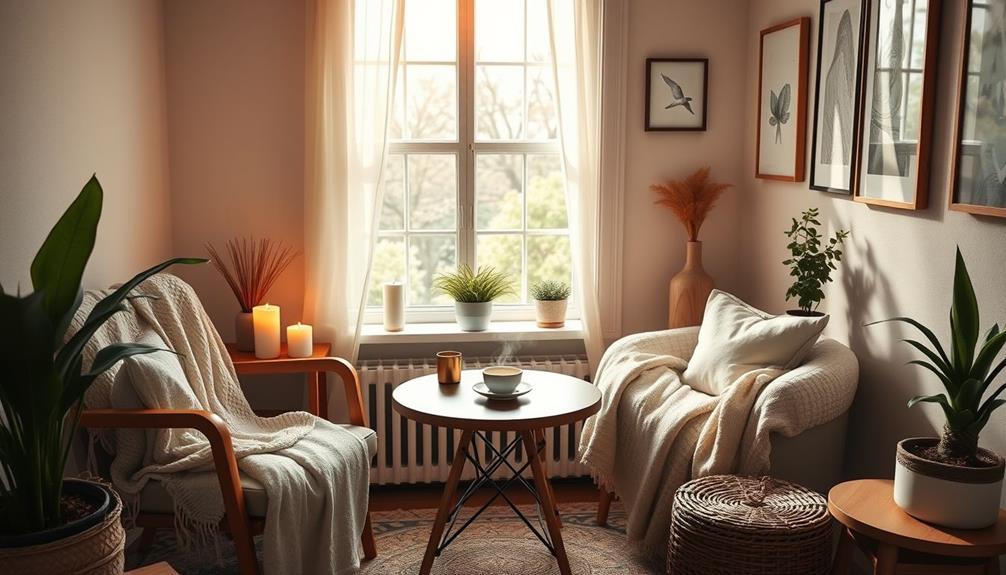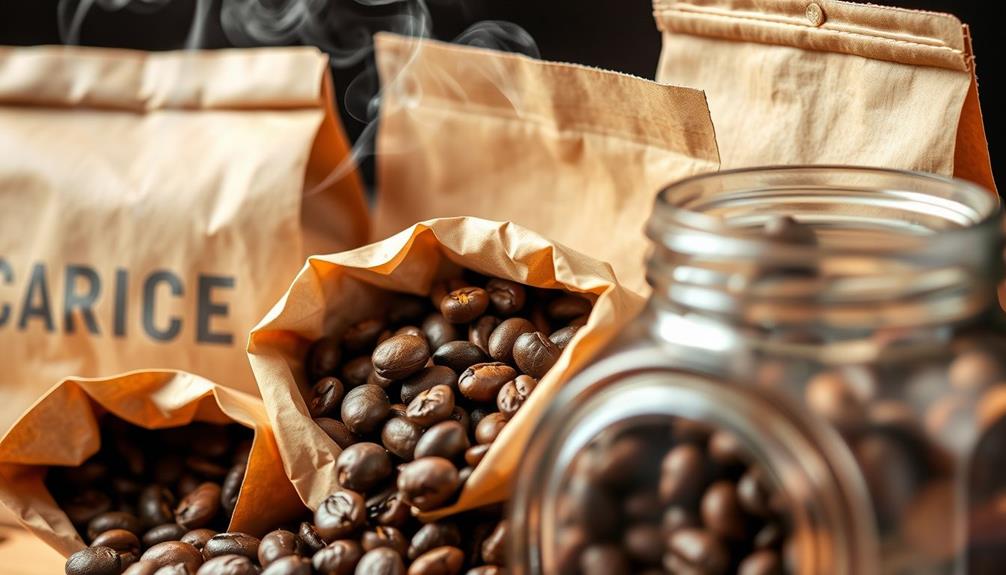Coffee Basics
Discover The Rich Flavor Of Kona Coffee!

I have always been a coffee lover, and my search for the perfect cup has led me to discover the rich and luxurious flavor of Kona coffee.
Grown exclusively on the slopes of Hualalai and Mauna Loa in Hawaii, Kona coffee is renowned for its sweet and nutty taste with low acidity.
Not only is it delicious, but Kona coffee is also processed using sustainable methods and has strict regulations ensuring its authenticity and quality.
In this article, I will take you on a journey to explore the history, characteristics, grading, health benefits, controversies, and brewing techniques of Kona coffee.
Whether you are a seasoned coffee connoisseur or just starting to appreciate the complexity of different coffee flavors, Kona coffee is sure to delight your taste buds and provide a unique and unforgettable experience.
So come with me as we discover the rich flavor of Kona coffee and all the fascinating aspects of this exquisite drink.
Key Takeaways
- Kona coffee is a unique Arabica variety grown on the slopes of Hualalai and Mauna Loa in Hawaii, with strict regulations in place to protect its authenticity and quality.
- The characteristics of Kona coffee include a sweet, nutty, and mild flavor with low acidity, grown on rich volcanic soil under optimal weather conditions and selectively harvested by hand.
- Kona coffee is graded based on size, shape, moisture content, and defects, with six different grades ranging from Extra Fancy to Prime.
- To fully enjoy the unique taste and experience of Kona coffee, it is important to properly source and brew the coffee using methods such as drip, French press, espresso machine, or pour-over, and to pair it with light foods like fruit, yogurt, or croissants.
Authenticity and Quality
I know some may be skeptical of the authenticity of Kona coffee, but let me assure you that strict regulations protect its quality.
To be considered true Kona coffee, the beans must be grown on the slopes of Hualalai and Mauna Loa in the Kona District of Hawaii. These regulations are enforced by law, ensuring that only the highest quality coffee beans are labeled as Kona coffee.
Unfortunately, there’s been an increase in counterfeit Kona coffee products in the market. To combat this issue, certification programs have been established by the Kona Coffee Farmers Association and Hawaii Department of Agriculture to verify the origin of the coffee beans and labels.
It’s important to purchase Kona coffee from reputable sources to avoid fake products and to ensure that you’re getting the authentic taste and quality of this renowned coffee.
Growing and Harvesting
Growing and harvesting Kona coffee involves selectively picking the highest quality beans by hand to ensure the unique characteristics of this Arabica variety are preserved.
The Kona District’s optimal weather conditions, rich volcanic soil, and strict regulations contribute to the exceptional quality of Kona coffee.
Additionally, irrigation methods and pest management are crucial in preserving the health and vitality of the coffee plants.
Drip irrigation is preferred as it conserves water and provides the plants with a constant supply of moisture.
Pest management in Kona coffee farming is also carefully monitored to ensure the quality of the beans.
Local farmers use organic methods to manage pests, including introducing beneficial insects and using natural repellents.
By carefully monitoring irrigation and pest management, Kona coffee farmers can produce high-quality beans that are sought after around the world.
Grading and Classification
When classifying Kona coffee beans, size is a crucial factor with Extra Fancy grade beans accounting for only 10% of the crop. The grading system categorizes beans based on their size, shape, moisture content, and defects. The highest grade, Extra Fancy, is given to beans that are the largest and have the least number of defects.
Size categories are determined by the width of the beans, with the largest beans being classified as Extra Fancy and the smallest as Prime. Defects assessment includes checking for discoloration, insect damage, and other abnormalities that could affect the quality of the beans. Grading factors also include altitude influence, with beans grown at higher elevations generally having a better flavor profile. It is important to note that Kona coffee is a highly regulated product, and only beans grown in the Kona district can be labeled as such. The strict regulations and grading standards ensure that consumers are getting a high-quality and authentic product.
| Grade | Size | Moisture Content |
|---|---|---|
| Extra Fancy | Largest beans | 9-12% |
| Fancy | Same as Extra Fancy but with slight defects | 9-12% |
| No.1 | Slightly smaller than Fancy with defects | 9-12% |
| No.2 | Smaller than No.1 with more defects | 9-12% |
| Prime | Smallest beans with most defects | 9-12% |
The table above illustrates the different size categories and moisture content of Kona coffee beans. As previously mentioned, Extra Fancy beans are the largest and have the least number of defects, while Prime beans are the smallest and have the most defects. It is important to note that while larger beans are generally preferred, the size of the bean does not necessarily determine the quality of the coffee. Other factors such as altitude, soil composition, and harvesting techniques can also greatly affect the flavor profile of the coffee.
Health Benefits and Sustainability
Research shows that antioxidants in this delicious brew may lower the risk of developing chronic diseases, and local farmers use sustainable methods to protect the environment.
Kona coffee is a healthy choice for coffee lovers who want to indulge in a cup of rich, flavorful coffee while also supporting fair trade and organic farming practices.
Kona coffee farmers are committed to using sustainable methods to grow their coffee beans. They use natural techniques to control pests and diseases, such as companion planting, crop rotation, and composting.
They also conserve water by using drip irrigation systems and capturing rainwater. In addition, many Kona coffee farms are certified organic, which means that they do not use synthetic pesticides or fertilizers that can harm the environment and human health.
By choosing Kona coffee, you can enjoy a delicious brew and support sustainable agriculture practices that benefit both people and the planet.
Brewing and Enjoyment
As a coffee lover, I enjoy experimenting with different brewing methods and grind sizes to bring out the unique characteristics of this luxury bean.
When it comes to Kona coffee, grinding the beans to the appropriate size is crucial in order to achieve the best flavor profile. I prefer a medium grind for my drip coffee maker, which allows for a balanced extraction and a smooth finish. However, if using a French press or pour-over method, a coarser grind is recommended to avoid over-extraction and bitterness.
In terms of flavor pairing suggestions, Kona coffee’s sweet and nutty notes make it a perfect match for light foods such as fruit, yogurt, or croissants. The mild acidity of Kona coffee also complements the delicate flavors of pastries and baked goods.
When enjoying Kona coffee, it’s important to use filtered water to avoid any unwanted flavors and to ensure a clean taste.
Overall, taking the time to properly source and brew Kona coffee will result in a rich and satisfying experience.
Frequently Asked Questions
What is the difference between Kona coffee and other types of coffee?
Comparing Kona coffee to other types is like comparing a Ferrari to a Honda. Kona Coffee Varieties like Typica and Caturra have a sweet, nutty flavor with low acidity. Brewing Tips include using filtered water and the right grind size for a perfect cup.
What are the challenges faced by Kona coffee farmers in terms of sustainability?
As a Kona coffee farmer, I face challenges in farm management and minimizing environmental impact. We implement sustainable practices such as composting and organic fertilizers to preserve the quality of the soil and water, ensuring the longevity and health of our farms.
How does the altitude at which Kona coffee is grown affect its flavor and quality?
The altitude at which Kona coffee is grown impacts its flavor profile. Higher altitudes produce a smoother and more complex taste, while lower altitudes yield a denser and chocolatey flavor.
Are there any unique brewing techniques recommended for Kona coffee?
I recommend using a French press or pour over for a clean and bright cup, or an espresso or drip for a richer and bolder flavor. Always use filtered water and grind fresh for optimal results.
Can Kona coffee be enjoyed as a cold brew or iced coffee?
When it comes to enjoying Kona coffee, there’s no one right way. While hot brewing brings out its sweet, nutty flavor, a cold brew or iced coffee recipe can offer a refreshing twist. Experiment and find your perfect cup.
Arf, an author and an innovative enthusiast of coffee, coffee alternatives, and tea, plays a crucial role as a contributor to the esteemed Cappuccino Oracle platform. Renowned for his curiosity and passion for these captivating beverages, Arf has carved out a unique space for himself in the world of exploration and writing. He realized that coffee, coffee alternatives, and tea are not mere drinks to keep one awake, but universes of flavors and stories waiting to be explored.
Arf’s articles for Cappuccino Oracle blend meticulous research with personal experiences, providing readers with an in-depth understanding of various types of coffee, coffee alternatives, and tea, along with their unique characteristics, cultures, and histories. His honest reviews and engaging narratives guide readers on their own journeys, helping them discover their preferences and find their perfect brew.
Coffee Basics
Mindful Coffee Consumption: Turning Your Daily Habit Into a Wellness Ritual
Brew a transformative experience with mindful coffee consumption that elevates your daily ritual—discover how it can enhance your wellness journey.

Mindful coffee consumption can elevate your daily habit into a wellness ritual. Start by engaging all your senses—observe the rich colors, listen to the brewing sounds, and inhale the inviting aromas. Create a calm space to focus on the process, appreciating each sip and the flavors it offers. Taking time to savor your coffee not only enhances enjoyment but also promotes relaxation and reduces stress. By integrating this mindful practice into your morning routine, you set a positive tone for the day. Discover the nuances of coffee and learn how it can transform your wellness journey even further.
Key Takeaways
- Create a calm brewing environment to enhance mindfulness and focus on the sensory experience of coffee preparation.
- Engage all senses by observing the colors, sounds, and aromas of coffee to elevate the overall enjoyment.
- Establish a ritual space that is clean and personalized to foster a deeper connection with your coffee routine.
- Incorporate slow brewing techniques to fully savor each step and appreciate the nuances of flavor in every sip.
- Use mindful coffee breaks during your day to boost concentration, emotional regulation, and overall well-being.
Health Benefits of Coffee

When it comes to health benefits, coffee proves to be more than just a morning pick-me-up. It's packed with antioxidants that can help protect your brain against neurodegenerative diseases like Parkinson's and Alzheimer's by reducing oxidative stress.
With moderate coffee consumption—about 3-4 cups daily—you can enhance your cognitive function and boost mental alertness, thanks to the stimulating effects of caffeine. Furthermore, understanding the differences between espresso and coffee can elevate your experience and appreciation for this beloved beverage, allowing you to fully enjoy its health benefits while savoring each cup.
Various brewing methods affect caffeine content considerably, making it essential to choose your method wisely.
Incorporating coffee into your daily routine can be a mindful approach to wellness. Studies suggest that responsible coffee consumption is linked to a lower risk of certain diseases, including type 2 diabetes and some cancers.
Additionally, caffeine can improve your physical performance by stimulating adrenaline release, making it a popular choice before workouts for increased endurance.
To maximize these health benefits while avoiding negative effects like jitters or sleep disruption, try to enjoy your coffee earlier in the day and stick to moderate amounts.
Mindful Consumption Practices

Mindful coffee consumption elevates your daily routine by engaging all your senses—sight, sound, smell, and taste. By turning your daily coffee ritual into a mindful practice, you can savor each sip, reduce stress and anxiety, and enhance your overall enjoyment. This sensory experience allows you to appreciate the intricate flavors and aromas, encouraging you to focus on the present moment.
| Sense | Experience | Benefit |
|---|---|---|
| Sight | Observe the rich colors of your brew | Enhances anticipation |
| Sound | Listen to the brewing process | Promotes relaxation |
| Smell | Inhale the fragrant aromas | Elevates mood |
| Taste | Savor the complex flavors | Increases satisfaction |
Incorporating mindful coffee breaks into your routine transforms them into moments of mental rejuvenation, allowing you to cultivate gratitude and joy. You'll feel a deeper connection with your daily experiences, making your coffee ritual not just a habit, but a source of wellness. Embrace mindful consumption, and watch how it enriches your life, one cup at a time.
Coffee Meditation Techniques

Transform your coffee ritual further by incorporating coffee meditation techniques. This mindful practice invites you to slow down and fully engage with the sensory experience of coffee.
Begin by creating a calm environment, free from distractions, as you prepare your brew. Pay close attention to the sound of grinding beans and the smell of fresh coffee filling the air, enhancing your appreciation for each element involved. Understanding the brewing methods can also enhance this sensory journey, helping you choose the perfect way to enjoy your coffee.
As you brew, observe the coffee's color and consistency, allowing these details to deepen your meditative experience. This intentional focus helps you turn your daily habit into a meaningful ritual, promoting tranquility and mental clarity.
By combining the stimulating effects of caffeine with mindfulness, you'll foster relaxation and heightened focus.
Once your coffee is ready, take a moment to savor each sip. Notice the warmth of the cup in your hands and the taste on your palate. This practice not only enhances your enjoyment but also supports your overall well-being, as regular coffee meditation can reduce stress and anxiety.
Embrace this mindful ritual and transform your coffee moments into a source of peace and appreciation.
Creating a Ritual Space

Creating a dedicated ritual space for your coffee brewing can greatly enhance your mindfulness practice. By designating a specific nook, you establish a calming environment that encourages a mindful ritual.
Start by ensuring your space is clean and uncluttered, as this fosters tranquility and allows for deep focus during your coffee preparation. Exploring various coffee varieties can also add excitement to your ritual, encouraging you to engage with the unique flavors and aromas each brew offers.
Consider personalizing your ritual space with meaningful decor or items that resonate with you. This simple act can elevate the significance of your coffee experience, transforming it into a cherished daily practice.
Think about incorporating elements that inspire you—perhaps a favorite mug, a plant, or artwork that brings you joy.
Optimal lighting plays an important role, too. Natural light can invigorate your senses, while warm, soft lighting can create a cozy atmosphere.
Additionally, attend to air quality; fresh, clean air enhances your enjoyment and immersion in the ritual.
Enhancing Your Morning Routine

Establishing a mindful coffee ritual can seamlessly blend into your morning routine, enhancing your overall experience. By taking the time to create a dedicated brewing space, you foster an environment that encourages mindfulness.
Slow down your brewing process, savoring each step from grinding the beans to pouring the warm cup. This intentionality promotes a sense of presence, allowing you to engage fully with the sensory experiences of aroma, texture, and flavor.
Additionally, incorporating practices such as mindful nutrition can further enrich your morning rituals, creating a holistic approach to wellness.
As you enjoy your coffee, focus on the nuances of each sip. This practice can deepen your appreciation for every cup and set a positive tone for the day.
Incorporating mindful coffee breaks into your daily routine not only boosts enjoyment but also links to improved concentration and emotional regulation, paving the way for a balanced, productive day ahead.
Frequently Asked Questions
Can I Practice Mindful Coffee Consumption With Decaf Coffee?
Absolutely, you can practice mindful coffee consumption with decaf coffee. Focus on the aroma, savor each sip, and appreciate the flavors. It's all about being present and enjoying the experience, regardless of caffeine content.
What Types of Coffee Brewing Methods Are Best for Mindfulness?
When you explore brewing methods, try pour-over or French press. These techniques let you focus on the process, from measuring coffee to observing the water's flow, creating a more intentional and mindful coffee experience.
How Can I Include Tea in My Mindful Ritual?
Tea time transforms tension into tranquility. Start by selecting soothing herbal blends, savoring each sip slowly. Engage your senses by noticing aromas and flavors, and embrace a peaceful pause, allowing mindfulness to flourish in your ritual.
Is It Possible to Do This Ritual in the Afternoon?
Absolutely, you can practice mindfulness in the afternoon. Take a break, brew your favorite beverage, and focus on the moment. Savor the flavors, breathe deeply, and let the day's stress melt away. It's rejuvenating!
What if I Dislike the Taste of Coffee?
Did you know that over 60% of Americans drink coffee daily? If you dislike coffee's taste, explore alternatives like herbal teas or chicory blends. You can still enjoy a comforting ritual without the coffee flavor.
Conclusion
As you sip your coffee, you're not just fueling your body; you're inviting peace into your chaotic morning. By embracing mindful consumption, you transform a simple habit into a powerful wellness ritual. Each cup becomes a moment of gratitude, balancing the rush of daily life with serene reflection. So, take a breath, savor the aroma, and let your coffee nourish both your body and soul, creating harmony in the midst of your busy day.
In the vast and diverse world of coffee, coffee alternatives, and tea, Olivia has found her calling. As an author and a dedicated coffee and tea aficionado, her work for Cappuccino Oracle reflects her profound love and understanding of the intricate complexities found within these beverages. Olivia’s passion for the subject serves as both a catalyst for her creativity and a connection point with her audience.
Olivia’s appreciation for coffee, coffee alternatives, and tea blossomed at an early age. She discovered that these beverages invigorated her senses and stimulated her creative spirit. From the nuanced flavors of single-origin roasts to the captivating narratives intertwined with coffee, coffee alternatives, and tea trade and culture, Olivia found an unlimited source of inspiration in her daily cup.
Her love for these beverages and her talent for storytelling eventually converged at Cappuccino Oracle. As an author, Olivia’s mission is to illuminate the intricate tapestry that makes up the world of coffee, coffee alternatives, and tea. Her articles span a diverse range of topics, encompassing everything from the unique flavors of different brews to the sociocultural history intertwined with their cultivation and consumption.
Coffee Basics
The Global Journey of Coffee: From Crop to Cup and Its Health Implications
Coffee’s captivating journey from crop to cup reveals surprising health benefits and cultural connections that may change how you enjoy your next sip.

Coffee begins its journey on farms where cherries ripen for about three to four years before harvest. Once ripe, the cherries are processed using dry or wet methods, enhancing their flavor before roasting. You benefit from this rich beverage, as coffee's high caffeine content and antioxidants can lower the risk of type 2 diabetes and enhance cognitive function. Sustainable practices, like Fair Trade, guarantee farmers receive fair compensation and support environmentally friendly methods. As you sip your coffee, consider how each cup connects to a broader narrative of health and culture, and there's much more to explore about its fascinating journey.
Key Takeaways
- Coffee trees take 3-4 years to produce ripe cherries, which are harvested once they turn red to ensure optimal flavor.
- The coffee processing methods, Dry and Wet, significantly influence the flavor profile of the beans before roasting.
- Roasting coffee at temperatures between 180°C and 240°C develops its unique flavors and aromas, essential for the final experience.
- Regular coffee consumption offers health benefits, including reduced risk of type 2 diabetes and enhanced cognitive function.
- Sustainable coffee practices, like Direct Trade and certifications, promote environmental responsibility and fair compensation for farmers.
The Journey of Coffee

The journey of coffee starts in lush plantations, where coffee trees thrive for 3-4 years before producing ripe cherries. Once these cherries turn red, it's time for you to harvest them. Quick processing is essential to avoid spoilage, and this is where methods like the Dry and Wet Methods come into play, enhancing the flavor of the coffee beans.
Understanding the mechanics of French press coffee can also improve your coffee experience at home. After processing, the cherries yield parchment coffee, which you'll dry to an ideal moisture level.
Milling follows, where hulling and grading based on size and quality prepare the beans for export. Did you know that global coffee production reached an impressive 152.7 million 60-kg bags in the 2015/16 season?
Once the green coffee beans are shipped in jute or sisal bags, they undergo the roasting process at temperatures between 180°C and 240°C. This vital step develops the distinctive flavors and aromas that define your favorite brewed coffee.
Each cup tells a unique coffee story, reflecting the rich traditions of coffee cultures around the world. So, whether you sip it for pleasure or its numerous health benefits, every cup of coffee has a journey worth celebrating.
Health Benefits of Coffee

Discovering the health benefits of coffee can transform your morning ritual into a wellness boost. With its rich caffeine content, coffee delivers more than just a morning pick-me-up. It's packed with antioxidants, often containing more than fruits and vegetables combined in the average diet, which contributes considerably to its health benefits.
Regular consumption of coffee has been linked to a reduced risk of chronic diseases, including type 2 diabetes, with studies showing that coffee drinkers may enjoy a 30-50% lower risk. Additionally, the unique flavor profiles and aromas of various coffee types can enhance your overall enjoyment, making every cup a delightful experience for your taste buds, just as coffee varieties and preparation techniques can offer exciting new ways to enjoy your brew.
Moreover, moderate coffee intake can lead to improved cognitive function, enhancing memory, reaction times, and overall mental alertness. Research also suggests that coffee may provide protective effects against neurodegenerative diseases like Alzheimer's and Parkinson's, potentially lowering your risk by 30-60%.
Additionally, the caffeine in coffee plays a vital role in weight management, boosting metabolism and increasing fat burning by 10% in obese individuals and up to 29% in those who are lean.
As you savor your cup, remember that coffee's journey from plantations to your mug offers not just flavor, but a myriad of health advantages that can enhance your daily life.
Cultural Significance of Coffee

Coffee isn't just a beverage; it's a cultural phenomenon that brings people together across the globe. Every day, billions enjoy freshly brewed coffee, making it an integral part of daily routines and social interactions.
From the bustling coffee houses of the 15th-century Arabian Peninsula to today's vibrant social hubs, coffee culture thrives on connection and conversation. Importantly, celebrity lifestyle insights reveal how coffee has become a staple in many famous personalities' routines, emphasizing its universal appeal.
In Ethiopia, the coffee ceremony exemplifies respect and community, showcasing the deep-rooted cultural practices surrounding coffee. This unique ritual transforms coffee into a shared experience, inviting guests to savor the rich flavor profile of the brew.
Similarly, Turkish coffee includes fascinating traditions like fortune-telling, highlighting the diverse ways people engage with this beloved drink.
As you explore the journey of coffee, you'll find regional variations like the condensed milk-rich Vietnamese coffee and the Italian classics, cappuccino and macchiato.
The third wave coffee movement further enhances coffee's status, focusing on quality, sustainability, and artisanal methods. This evolution not only celebrates unique coffee but also reinforces coffee's role as a cultural connector, offering comfort and fostering connections in a fast-paced world.
Coffee Production Process

Cultivating coffee is a meticulous process that starts with coffee trees, which typically take three to four years to produce ripe cherries. You'll find that these cherries are harvested once a year, using methods like strip picking or selective picking.
After harvesting, processing the coffee cherries within hours is essential to prevent spoilage, as improper handling can lead to undesirable flavors in the final product. Additionally, just as with other agricultural products, careful attention to the environmental conditions can greatly impact the quality of the coffee, making it important for farmers to understand their local ecosystems and practices the significance of selecting the right cold medication.
You can choose between the Dry Method, where cherries are sun-dried, or the Wet Method, which involves removing the pulp and fermenting the beans.
Once the cherries are processed, the beans are dried to achieve an ideal moisture content of about 11%. This transforms them into parchment coffee before milling, where hulling and sorting occurs based on size and quality.
The resulting milled beans are known as green coffee and are packed in jute or sisal bags for export. In the 2015/16 season, global production reached an impressive 152.7 million 60-kg bags.
The roasting process is where the magic happens, as heating green beans to temperatures between 180°C and 240°C develops their unique flavor and aroma, turning them into the aromatic brown beans you enjoy in your cup.
Sustainable Coffee Practices

Sustainability in coffee production is more than just a buzzword; it represents a commitment to environmentally friendly practices that assure the longevity of this beloved beverage.
By embracing sustainable coffee practices, you're not only contributing to a healthier planet but also supporting coffee farmers and their communities. Additionally, just as investors seek tax advantages through strategic financial decisions, consumers can also make impactful choices that benefit both the environment and the economy.
Here are four key aspects of sustainable coffee practices:
- Direct Trade: This approach guarantees fair compensation for coffee farmers, enhancing their livelihoods and promoting ethical sourcing.
- Certifications: Labels like Fair Trade and Rainforest Alliance raise awareness about sustainability, guiding your purchasing decisions toward responsible brands.
- Environmentally Friendly Cultivation: Techniques, such as Costa Rica's carbon-neutral farms and Colombia's bird-friendly certifications, focus on minimizing ecological impact while adapting to climate change.
- Third-Wave Coffee Movement: This trend emphasizes quality and sustainability, driving demand for artisanal coffees from farms committed to responsible cultivation practices.
Frequently Asked Questions
What Is the Global Impact of Coffee?
You'll find coffee considerably impacts economies, connecting farmers and consumers globally. It fosters community interactions in cafes, drives demand for quality and sustainability, and shapes cultural habits, highlighting its importance in daily life and social dynamics.
How Does Globalization Affect Coffee?
Isn't it ironic how globalization, while shrinking your world, expands your coffee choices? You now sip brews from Brazil or Ethiopia, all while impacting local farmers' lives and the planet's sustainability. It's a complicated brew, isn't it?
What Are the Negative Effects of Coffee Farming?
Coffee farming's negative effects include deforestation, pesticide contamination, soil depletion, and exploitative labor practices. You'll also find climate change threatening farmer livelihoods, as rising temperatures reduce suitable land for coffee cultivation, impacting global supply.
How Did the Columbian Exchange Affect Coffee?
The Columbian Exchange transformed coffee by introducing it to the Americas, expanding cultivation and altering trade. You'll notice how Brazil became a major producer, influencing global consumption and agricultural practices considerably.
Conclusion
As you sip your favorite brew, consider how that rich flavor reflects a global journey, from crop to cup. Coffee isn't just a delightful beverage; it offers numerous health benefits and holds cultural significance across the world. By supporting sustainable practices, you can help protect the environment and the livelihoods of farmers. So, isn't it fascinating to think about the story behind every cup you enjoy? Your choice matters—make it count!
In the vast and diverse world of coffee, coffee alternatives, and tea, Olivia has found her calling. As an author and a dedicated coffee and tea aficionado, her work for Cappuccino Oracle reflects her profound love and understanding of the intricate complexities found within these beverages. Olivia’s passion for the subject serves as both a catalyst for her creativity and a connection point with her audience.
Olivia’s appreciation for coffee, coffee alternatives, and tea blossomed at an early age. She discovered that these beverages invigorated her senses and stimulated her creative spirit. From the nuanced flavors of single-origin roasts to the captivating narratives intertwined with coffee, coffee alternatives, and tea trade and culture, Olivia found an unlimited source of inspiration in her daily cup.
Her love for these beverages and her talent for storytelling eventually converged at Cappuccino Oracle. As an author, Olivia’s mission is to illuminate the intricate tapestry that makes up the world of coffee, coffee alternatives, and tea. Her articles span a diverse range of topics, encompassing everything from the unique flavors of different brews to the sociocultural history intertwined with their cultivation and consumption.
Coffee Basics
Coffee Storage Myths Debunked: Best Practices for Freshness and Flavor
Coffee storage myths can derail your morning brew; discover essential practices to maintain freshness and flavor that will transform your coffee experience forever.

Storing coffee properly is essential for keeping it fresh and flavorful, but many myths can mislead you. For instance, don't refrigerate your beans; it introduces moisture and odors that ruin taste. Always choose airtight containers made of dark glass or ceramic to shield your coffee from light and air. Ground coffee loses flavor quickly, so grind beans just before brewing. Whole beans can last months if stored correctly, while opened ground coffee should be used within two weeks. Follow these best practices, and you'll enhance your coffee experience greatly. There's so much more to explore about keeping your brew at its best!
Key Takeaways
- Storing coffee in the fridge introduces moisture and odors, negatively affecting flavor; keep it in a cool, dark place instead.
- Whole beans stay fresh for months when stored properly, while ground coffee should be consumed within two weeks for optimal flavor.
- Use airtight containers made of dark glass or stainless steel to limit exposure to air, light, and moisture, preserving freshness.
- Grind coffee just before brewing to maximize flavor; ground coffee loses over 50% of its aroma within 30 minutes of grinding.
- Avoid clear packaging; opt for dark, hermetically sealed bags to protect against light and oxygen degradation for longer-lasting freshness.
Common Coffee Storage Myths

When it comes to coffee storage, many people hold onto myths that can compromise the quality of their brew. One common misconception is that you should store coffee in the fridge. This can actually lead to moisture absorption and unwanted flavor changes due to coffee's porous nature. Instead, you should keep your coffee in an airtight container at room temperature.
Understanding the importance of proper brewing methods can further enhance your coffee experience by ensuring that you start with the best possible ingredients.
Another myth is that adding items like apple peels can absorb moisture in coffee storage. This practice is unnecessary and can introduce undesirable flavors to your coffee.
Also, many believe that ground coffee can be stored as long as whole beans, but that's not true. Ground coffee loses freshness considerably faster because it's exposed to air and light.
Some folks think clear packaging is fine for storing coffee, but transparent bags don't protect against light exposure, which can degrade flavor.
Finally, many assume unopened coffee stays fresh indefinitely. In reality, specialty coffee can maintain its freshness for six weeks if sealed, but once opened, you should consume it within two weeks for the best flavor.
Understanding these myths is essential for ensuring your coffee freshness and shelf life.
Importance of Proper Packaging

Proper packaging makes all the difference in preserving the rich aromas and flavors of your coffee. To maintain freshness, consider using one-way valve bags, which allow gases from roasted coffee beans to escape while keeping air out. This method is vital in preventing oxygen degradation, a primary enemy of coffee freshness.
Additionally, the variety of coffee you choose can impact how you should store it, as different beans possess unique flavor profiles and aromas, often sourced from specific regions known for quality unique flavor profiles.
Dark packaging is important, too. It protects your coffee from light exposure, which can lead to rancidity. Transparent bags might look appealing, but they're ineffective for long-term storage. Instead, opt for airtight containers or vacuum-sealed bags to greatly extend the shelf life of your beans.
Smaller portions are also a smart choice; they help reduce waste and guarantee that your coffee remains fresh longer. Specialty coffee in sealed bags can stay fresh for six weeks or more when unopened.
Lastly, remember that the choice of packaging affects both economic and environmental costs. By making mindful decisions and investing in proper packaging, you not only optimize the freshness of your coffee but also contribute to reducing waste in the long run.
Ideal Storage Conditions

To keep your coffee at its best, ideal storage conditions are just as important as the right packaging. Start by using airtight containers made of dark glass, ceramic, or stainless steel. These materials limit exposure to air, light, and moisture, which can degrade coffee quality.
Additionally, understanding the importance of budgeting your coffee purchases can help you invest in high-quality beans that deserve proper storage. The ideal storage temperature for your coffee is between 10°C and 25°C (50°F to 70°F). Extreme temperatures can adversely affect flavor and aroma retention.
Avoid placing your coffee near heat sources or in direct sunlight, as these conditions can accelerate rancidity and diminish freshness. It's also best to steer clear of refrigeration. The moisture and odors present in the fridge can negatively impact your coffee's flavor profile, leading to a less enjoyable experience.
To maintain the freshest and most flavorful coffee, opt for hermetically sealed containers. This storage method prevents oxygen and humidity from compromising the coffee's quality over time.
Best Practices for Grinding

Grinding your coffee just before brewing is essential to preserving its flavor, as it loses more than half its aroma within 30 minutes.
To enhance your experience, consider exploring the themes of positivity and warmth found in uplifting music while you prepare your coffee.
To get the best taste, aim to grind your beans within an hour of brewing and adjust your grind size based on your method.
Regularly cleaning your grinder also helps keep those flavors intact, ensuring each cup is as fresh as possible.
Grinding Timing Importance
While you might be tempted to grind your coffee ahead of time for convenience, doing so can considerably diminish its aroma and flavor. Coffee loses over 50% of its aroma and flavor within just 30 minutes after grinding due to oxidation.
To guarantee you enjoy the best cup, consider these best practices for grinding timing:
Regularly checking and maintaining your coffee equipment is essential for peak performance, just like air purifier maintenance.
- Grind your coffee no more than one hour before brewing.
- Adjust your grind size based on your brewing method; finer grinds are ideal for espresso while coarser grinds work for French press.
- Invest in a quality grinder for a consistent grind size, which enhances extraction and flavor.
- Avoid over-grinding, as it generates heat and leads to a loss of essential oils.
Grinder Maintenance Tips
Maintaining your grinder is essential for consistently great coffee, as neglected equipment can compromise flavor and aroma. Regular grinder maintenance prevents old coffee residues from contaminating your fresh grounds, which can lead to undesirable tastes.
Additionally, cold medications overview emphasizes the importance of selecting the right tools for effective results, similar to guaranteeing proper grinder function for peak coffee quality. Make it a habit to clean your grinder frequently to guarantee peak performance and quality coffee.
When it comes to storage, keep only the daily required amount of whole bean coffee in the grinder's container. This practice minimizes air exposure, reducing oxidation and preserving coffee freshness.
Additionally, adjust the grind size based on your brewing method—espresso and French press each require specific grind sizes for peak extraction.
Stay vigilant about your grinder's performance. If it starts to slow down or become noisy, it may indicate that the grinding mechanism needs replacement.
Ground Coffee Vs. Whole Beans

When it comes to freshness, whole beans outlast ground coffee by several months if stored properly.
This is particularly important for those who enjoy a rich coffee experience, as grinding just before brewing helps you capture the full flavor, as ground coffee begins to lose its aroma within minutes of exposure to air.
Proper coffee brewing essentials can greatly enhance your coffee experience.
Understanding these differences can greatly enhance your coffee experience.
Freshness Duration Comparison
If you want to enjoy the best flavor from your coffee, understanding the freshness duration of ground coffee versus whole beans is essential. Whole beans maintain their freshness longer, often lasting several months with proper storage.
In contrast, ground coffee loses its ideal flavor within two weeks of opening due to increased exposure to air and oxidation. Additionally, storing your coffee in a cool, dark place can further enhance its longevity and flavor profile, similar to how juice diets require careful consideration of storage for ideal health benefits.
When considering freshness duration, keep these points in mind:
- Whole beans can stay fresh for several months if stored correctly.
- Ground coffee should be consumed within two weeks after opening for the best flavor experience.
- Freshly ground coffee can lose over 50% of its aromatic properties within just 30 minutes.
- Specialty coffee in sealed bags can remain fresh for six weeks or longer when unopened.
To maximize flavor extraction, always grind your coffee just before brewing. This practice preserves the essential oils and flavors that degrade quickly once the coffee is ground.
Grinding Impact on Flavor
Choosing whole beans over pre-ground coffee not only preserves freshness but also considerably impacts the flavor profile of your brew. Whole beans can maintain their quality for several months when stored properly, while ground coffee starts to lose its flavor within just 30 minutes of grinding. This rapid oxidation means you could miss out on over 50% of the flavor compounds if you don't grind just before brewing.
Additionally, like the significance of early detection in mammography guidelines, grinding your coffee just before brewing is vital for maximizing flavor.
For the best results, aim to grind your beans within one hour of brewing. If ground coffee is exposed to air or not stored correctly, it can become stale even faster. Investing in a quality grinder is essential, as the consistency of your grind influences extraction. For instance, you'll want a finer grind for espresso and a coarser one for other brewing methods.
Pre-ground coffee often has a shorter shelf life due to increased oxidation, making whole beans the preferable choice for coffee lovers seeking to maintain freshness and enhance flavor. By grinding your beans right before brewing, you're ensuring that each cup of coffee delivers the rich, aromatic experience you crave.
Refrigeration and Freezing Risks

Although many people believe refrigeration or freezing can help preserve coffee freshness, these methods can actually harm its quality. Storing coffee in the refrigerator introduces moisture and odors, which negatively affect the coffee's flavor due to its porous nature.
Additionally, just as essential oils like eucalyptus oil can help clear sinus congestion, the freshness of coffee requires careful consideration of storage methods. Both whole beans and ground coffee are vulnerable to these issues, making refrigerator storage unsuitable for maintaining quality.
If you consider freezing your coffee, keep in mind that it can extend shelf life only if done properly. Here are some key points to remember:
- Use airtight, single-serving doses in vacuum-sealed bags to prevent moisture.
- Avoid opening frozen bags frequently; each time you do, you risk introducing moisture and odors.
- Most consumers lack the necessary tools for effective freezing, leading to potential flavor damage.
- Confirm you handle frozen coffee carefully to maintain its integrity.
Ultimately, while refrigeration and freezing seem like good options for preserving coffee, they often do more harm than good. Instead, focus on proper storage methods that safeguard your coffee's freshness and flavor without the risks associated with moisture and odors.
Evaluating Coffee Freshness

Understanding how to evaluate coffee freshness is key to enjoying the best flavors your brew can offer. Freshness plays a crucial role in coffee quality; stale coffee can lose up to 60% of its flavor due to factors like air, light, heat, and moisture. To maintain your coffee's freshness, pay attention to aroma and taste.
| Indicator | Freshness Level |
|---|---|
| Rich and vibrant | Fresh |
| Dull and flat | Stale |
| Whole bean | Lasts months |
| Ground coffee | Use within 2 weeks |
| Local roaster | Best flavor |
The significance of proper storage cannot be overstated. Always keep your coffee in a dry place, away from light and heat. When you evaluate coffee freshness, regularly check the aroma and flavor profile. A balanced taste indicates high quality, while dull flavors suggest degradation. Remember, purchasing fresh coffee from local roasters and grinding just before brewing will maximize flavor retention, enhancing your overall experience. So, prioritize evaluating coffee freshness to enjoy the best brew possible!
Frequently Asked Questions
What Are the Two Biggest Enemies to the Freshness of Coffee?
The two biggest enemies to your coffee's freshness are oxygen and moisture. They can quickly degrade flavor and aroma, so it's essential to store your beans properly to keep them tasting their best.
How Should Coffee Be Stored to Maintain Freshness?
You think keeping coffee in the fridge is smart? Think again! Store it in an airtight container, away from light and moisture, in a cool, dry place. Freshness thrives, while your fridge just ruins!
What Are the Four Enemies of Coffee Freshness?
The four enemies of coffee freshness are air, heat, moisture, and light. They degrade flavor and aroma, so you should store your coffee in a cool, dry, dark place to keep it tasting its best.
Does Keeping Coffee in the Refrigerator Keep It Fresh?
Studies show that coffee stored in the refrigerator loses flavor 15% faster than when kept in a cool, dry place. You shouldn't keep coffee in the fridge; it absorbs moisture and odors, ruining its freshness.
Conclusion
In the world of coffee, storing it right is like crafting the perfect brew—it makes all the difference. By busting common myths and following best practices, you can savor every sip of freshness and flavor. Remember, treat your coffee with care, and it'll reward you with a rich experience. So, ditch the misconceptions, embrace proper storage, and enjoy your daily cup as it was meant to be—bold, aromatic, and utterly delightful!
In the vast and diverse world of coffee, coffee alternatives, and tea, Olivia has found her calling. As an author and a dedicated coffee and tea aficionado, her work for Cappuccino Oracle reflects her profound love and understanding of the intricate complexities found within these beverages. Olivia’s passion for the subject serves as both a catalyst for her creativity and a connection point with her audience.
Olivia’s appreciation for coffee, coffee alternatives, and tea blossomed at an early age. She discovered that these beverages invigorated her senses and stimulated her creative spirit. From the nuanced flavors of single-origin roasts to the captivating narratives intertwined with coffee, coffee alternatives, and tea trade and culture, Olivia found an unlimited source of inspiration in her daily cup.
Her love for these beverages and her talent for storytelling eventually converged at Cappuccino Oracle. As an author, Olivia’s mission is to illuminate the intricate tapestry that makes up the world of coffee, coffee alternatives, and tea. Her articles span a diverse range of topics, encompassing everything from the unique flavors of different brews to the sociocultural history intertwined with their cultivation and consumption.
-

 Coffee Alternatives And Tea4 weeks ago
Coffee Alternatives And Tea4 weeks agoThe Coffee Alternative That’s Helping People Live to 100
-

 Coffee Alternatives And Tea2 weeks ago
Coffee Alternatives And Tea2 weeks agoNutritionists Are Raving About This Coffee Alternative – Here’s Why
-

 Coffee Alternatives And Tea2 weeks ago
Coffee Alternatives And Tea2 weeks agoThe ‘Miracle Tea’ That’s Helping People Sleep Better Than Ever
-

 Coffee, Tea and Alternatives and Health plus Fitness2 weeks ago
Coffee, Tea and Alternatives and Health plus Fitness2 weeks agoThe Shocking Reason Health Experts Are Abandoning Green Tea
-

 Coffee Alternatives And Tea2 weeks ago
Coffee Alternatives And Tea2 weeks agoThe Tea That’s So Good, It’s Causing Shortages Worldwide
-

 Coffee Alternatives And Tea2 weeks ago
Coffee Alternatives And Tea2 weeks agoThis Coffee Substitute Promises to Double Your Productivity
-

 Coffee Alternatives And Tea2 weeks ago
Coffee Alternatives And Tea2 weeks agoThe ‘Super Brew’ That’s Making Energy Drinks Look Like Soda
-

 Coffee Alternatives And Tea2 weeks ago
Coffee Alternatives And Tea2 weeks agoCoffee Lovers Are Freaking Out Over This New Alternative




























